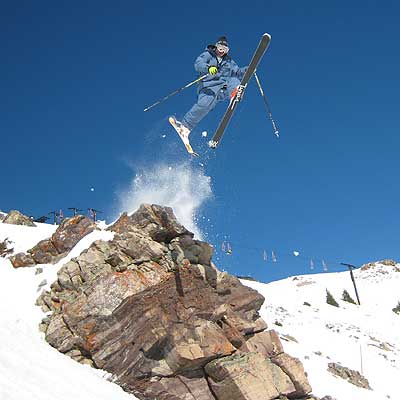Customize P90X for Skiing: Put together a Short Training Cycle
 Since I’m sitting here in a snowstorm, it seems like a good idea to address how to use P90X to get your body ready for snow sports before it’s too late. If you recall the principles discussed 2 weeks ago (see “Customizing P90X for Specific Goals: Part I” in the Related Article section below), you might think it’s already too late. Luckily, Tony is a skier and he always designs programs with skiing in mind. This makes customizing P90X for skiing very simple.
Since I’m sitting here in a snowstorm, it seems like a good idea to address how to use P90X to get your body ready for snow sports before it’s too late. If you recall the principles discussed 2 weeks ago (see “Customizing P90X for Specific Goals: Part I” in the Related Article section below), you might think it’s already too late. Luckily, Tony is a skier and he always designs programs with skiing in mind. This makes customizing P90X for skiing very simple.
It’s funny how we don’t get ski questions until it’s already snowing outside. In a perfect world, you’d begin your training for skiing as soon as the last season ended. This would give your body time to adapt and grow strong before it needed to engage in the rigors of the sport. But we don’t live in a perfect world, so today we will look at how to structure a short training cycle.
Your foundation
Last time we covered your foundation and how effectively P90X develops it. No matter what your goals are, you first want to make sure your fitness base is sound enough for you to engage in more specific training. Skiing is a core- and leg-based sport, meaning that a customized program includes more targeted work on these areas. However, if you can’t do all the movements in Legs & Back or fall over during Plyometrics, you need to continue building your base before you start to customize.
Remember that Tony is a skier. This means P90X is already good conditioning for skiing, and mastering the basic schedule is more important than customizing, even if you have a ski trip on the horizon. This is different than if you had, say, an upcoming triathlon. Endurance-based sports (or power-based sports) require a different strategy that we’ll get to in another article. For skiing, your first goal is mastery of the classic P90X schedule.
Periodization
All training programs are somehow based on periodization. If you don’t know what that is, read “Customizing P90X for Specific Goals: Part I” in the Related Article section below. Periodization involves you doing blocks of training designed around a goal before you move into the next block of training. The various blocks of a program lead toward a point where your body should peak. Below is an example using P90X.
Foundation phase (Power 90® or what you did pre-X) + block 1 + transition/recovery + block 2 + transition/recovery + block 3 + recovery = peak (final fit test)
A training cycle can be any length of time. P90X is 90 days, but you can effectively design a training cycle that lasts anywhere from 2 weeks to an entire year.
The longer the cycle, the harder the individual blocks can be. The reason is that you only need to peak at the end of the given cycle. Therefore, it’s okay to design your training to the point where you’re in a state of almost total breakdown early in a program. Most people hobble around during the first couple blocks of P90X. During this period, you wouldn’t want to ski (or do anything) at your highest level.
This means that short training cycles should be easier than longer ones. Excessive breakdown, like the kind you may have experienced the first couple of times you did Plyometrics, happens when you engage something called type IIb muscle fibers. These are fast twitch muscle fibers that your body has saved for emergencies. These fibers are essential for maximum power, but once you use them, they take a long time to heal, usually around 2 weeks. So you obviously wouldn’t want to destroy them at the start of a 2-week training cycle.
This is why your foundation is so important. If you can’t do P90X classic without getting sore, it won’t help you to make this schedule harder, especially close to a ski trip. It would just result in further breakdown and have you hitting the slopes without a full contingent of your fast twitch muscles fibers, which are exactly what you’ll need to land a jump or dart between trees at 30 mph. If you want to stay injury free, you won’t want to hit the slopes in any state of breakdown.
Progressive overload
You always want progressive overload to occur in a training program (defined in “Customizing P90X for Specific Goals: Part I”). This simply means that the program should build on itself over time.
Recovery
Defined in “Customizing P90X for Specific Goals: Part I,” recovery promotes the healing of your fast twitch muscle fibers. When you recover toward a peak, it’s to allow your body to build these muscle fibers up. Only high-level training engages fast twitch fibers, which is why recovery weeks skip heavy lifting and plyometrics and focus on aerobic conditioning, flexibility, and training your stabilizer muscles.
Putting it all together
The first thing you need to consider is how much time you have. The longer the better (you know, “plan ahead”). No matter what your training program is, it should target a specific date you want your body to be at its peak.
When you have a long period of time, you can structure your training toward your weakness. For example, if you don’t have the leg strength to land a certain jump, you could build up the size and then the strength of your legs during the off-season. If you’re already in the season, however, the muscular breakdown required to do this will inhibit your ability to ski well.
Short cycles should focus more on mastering sports-specific movements. To do this, you use what are called integration exercises. These are the opposite of the types of isolation movements that you do for sheer hypertrophy, or muscle growth. Integration movements target strength, speed, and neuromuscular coordination. P90X is loaded with integration movements.
For our example, given that it’s December, let’s use a 1-month time frame. This is a very short training cycle, but it’s still enough time to fine-tune your body. Shoot, Rocky only had 3 weeks to train for Apollo Creed!
The next thing you do is decide which workouts are the most sports specific. For skiing, you obviously want Plyometrics and Legs & Back. Tony Horton’s One on One Plyo Legs (Volume 1, Disc 1) is a unilateral (one leg at a time) workout that is outstanding for skiing. Yoga, too, is very ski specific, and it trains the stabilizer muscles that get worked overtime when you do a sport on an unstable surface like snow. You don’t need much upper-body mass to ski, but you do need upper-body strength. Therefore, the standard weight-training routines should be dropped in favor of Core Synergistics. Again, we’re looking for strength and balance moves together—integration. So the key elements of your program will be the legs workouts, core synergistics, and yoga.
Alpine skiing (Nordic skiing will be addressed during the endurance sports article) doesn’t require any specific cardio training if your foundation is strong. It’s what’s called a power-endurance sport, meaning that your anaerobic system is taking the brunt of the abuse. You need a solid aerobic base to recharge your anaerobic system, but all of P90X’s workouts address that aspect to some degree. Therefore, workouts like Kenpo X will be fillers and not an essential part of your training structure. This means that if something in the schedule is getting skipped, make sure it’s your cardio workout.
Sample schedule
Here is a sample training cycle using P90X, designed for a ski trip that’s 1 month away. This schedule is for someone who can do a given week of P90X classic without getting very sore. Note that this cycle has no training blocks. There simply isn’t time.
Week 1
* Day 1: Plyometrics
* Day 2: Yoga X
* Day 3: Core Synergistics
* Day 4: Legs & Back
* Day 5: Kenpo X
* Day 6: Plyometrics
* Day 7: Yoga X
Note: There is no “rest day” because of the time constraints of the program.
Week 2
* Day 1: Core Synergistics
* Day 2: Legs & Back
* Day 3: Kenpo X
* Day 4: Plyometrics
* Day 5: Yoga X
* Day 6: Core Synergistics
* Day 7: Legs & Back
Week 3
* Day 1: Kenpo X
* Day 2: Plyometrics
* Day 3: Yoga X
* Day 4: Core Synergistics
* Day 5: Legs & Back
* Day 6: Yoga X
* Day 7: Plyometrics
Note: The change at the end is for maximum breakdown during the last hard bit of the 1-month cycle. Now it’s time to slow down before your trip. Hard training during your recovery will negatively affect your ability to perform well.
Week 4
* Day 1: X Stretch
* Day 2: Core Synergistics
* Day 3: Kenpo X
* Day 4: Cardio X
* Day 5: Yoga X
* Day 6: X Stretch
* Day 7: X Stretch
During your trip, begin the day with some light yoga to warm you up for skiing. Ending each day with X Stretch or something similar will help you perform better the following day. Now rip it up and have fun!
Article by Steve Edwards




One Comment